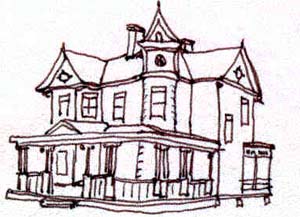Home > Old houses > Queen anneQueen Anne
Queen Anne houses, also known as American Queen Anne Style homes, are an important part of American architectural history. A subtype of the late 19th century Victorian style homes, the Queen Anne style emerged in England during the reign of Queen Anne (1702-1714). The style was very popular in the United States until the early 20th century, when it was largely replaced by modernism. Although Queen Anne homes have seen a resurgence in popularity in the 21st century, they still remain some of the most distinctive and attractive of all Victorian style homes.
Queen Anne homes are easily distinguished by their ornate architecture and decorative features typical of the Victorian era. The style includes steeply pitched roofs, balconies, wrap-around porches, and corner towers – all of which contribute to the home’s distinct silhouette. The structures are usually made from wood and painted in bright and vibrant colors such as yellows, reds, and blues. Windows are usually situated in an asymmetrical pattern, often leading to a spacious wrap-around porch. The typical Queen Anne home also features detailed trimming around windows and doors, spindlework, and patterned shingles that further contribute to the home’s unique design.
Underscoring the splendor of the home’s exterior is an equally impressive interior. Interiors of Queen Anne homes are often designed to be as warm and inviting as possible, with an emphasis on comfort and homegrown charm. Common features include an abundance of stained wood, wooden floors, leaded glass windows, and detailed wall treatments including wallpaper and stenciling. Interiors also feature detailed woodwork, cornice moldings, picture rails, and bay windows. One of the most characteristic features of Queen Anne homes is the presence of built-in side tables and window seats. These features are often referred to as “wraparound” which contribute to the home’s cozy atmosphere.
Primarily associated with the wealthy and affluent, Queen Anne houses were most often found in urban areas. To this day, some of the most recognized examples of the Queen Anne style still remain scattered throughout America – from large and majestic mansions, to smaller urban dwellings. No matter the size, Queen Anne homes are distinguished by their intricate design and splendor. They often remain at the forefront of the minds of homeowners, architecture-lovers, and general admirers of the grandeur of the Victorian era.
The Queen Anne style of architecture was first popularized in England during the reign of Queen Anne (1702-14), but came to full flourishing by the 19th century. In the United States, the Queen Anne style became incredibly popular in the late Victorian era and is still associated with wealthy, opulent homes to this day. The Queen Anne style is defined by its ornamental detailing rather than by its larger scale components like walls and windows. Its defining characteristics can include turrets and towers, half-timbering, wrap-around porches, asymmetrical façades, leaded glass windows, multicolored slate roofs, and more. The style is often complemented by dark colors and shingles to create a dramatic, yet inviting and homey feel to the property.
This paper will detail the design of a hypothetical 2000 sq. ft, 3-bedroom, 2-bath Queen Anne house. The objective is to create a modernized version of the Queen Anne style that is functional, aesthetically pleasing and energy efficient. The main floor of the house would contain two bedrooms, a living room, a dining room, a kitchen, and a full bathroom. Notable characteristics of a Queen Anne style house include light, airy, and open spaced rooms so large windows and light paint colors would be featured heavily throughout the house. The walls could be papered and the ceilings would feature crown moldings.
The exterior of the house would be the most standout feature of the design. A turret and wrap-around porch would be included to shield from the hot sun. The porch would also provide a comfortable space for outdoor activities. Lead glass windows, a decorative entry door, and other ornamental design features such as quoins, dentils, and coffers would be included to add to the opulent feel of the house. A multicolored slate roof and multiple gables would complete the picture.
The homeowner would have the choice to use natural materials for the house, such as cedar, clay, or brick, to create a rustic and elegant look. Shingles and wood clapboard or shingles would also be an appropriate option for Queen Anne houses. Complimenting the natural finishes would be modern amenities such as double-paned windows, solar panels, and low-flow plumbing fixtures. These features would increase the energy efficiency of the home, as well as the value.
It is evident that with thoughtful and careful consideration, a modern version of a Queen Anne house can be realized while still retaining the classic style that is synonymous with luxurious living. The design of a Queen Anne house is an exercise in creativity, and the balance between old and new. This paper has outlined the elements that would be included when designing a 2000sq.ft Queen Anne House, enabling the homeowner to create the house of their dreams while still paying homage to the style’s rich history.










